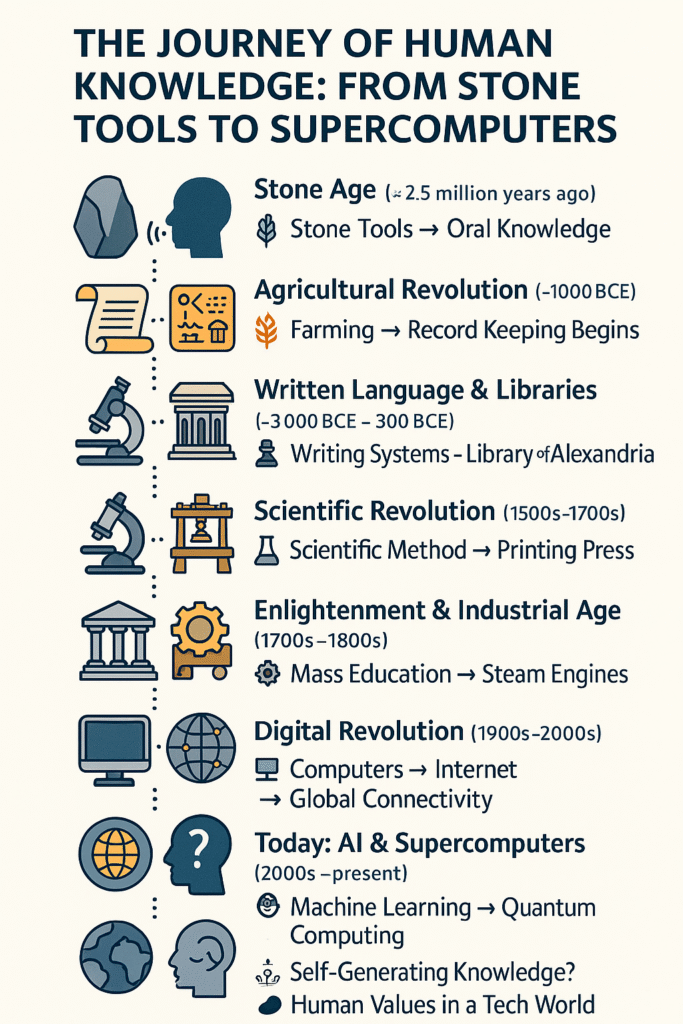1. The Dawn of Thought: Stone Tools and Survival Skills
Over 2.5 million years ago, early humans began shaping stones into tools. These weren’t just sharp rocks — they were our first attempt to solve problems, remember methods, and pass on practical knowledge.
- Stone tools taught us how to hunt, build, and adapt.
- Knowledge was passed down orally, by watching and imitating elders.
This was the foundation of applied knowledge — hands-on learning in its rawest form.

2. The Agricultural Revolution: Organizing Knowledge
Around 10,000 years ago, humans transitioned from hunting and gathering to farming. This change required new knowledge systems:
- Understanding seasons, soil, and irrigation
- Storing surplus food
- Domesticating animals
It also introduced written records, such as symbols on clay tablets — the beginning of human literacy and documentation.
3. The Birth of Writing and Early Libraries
By 3,000 BCE, civilizations like Sumer and Egypt developed written languages. This was a massive leap: instead of just passing knowledge by word of mouth, we could now record and preserve it.
- Ancient libraries stored tablets and scrolls
- Knowledge became institutionalized — held by priests, scribes, and elites
- The Library of Alexandria (built around 300 BCE) aimed to collect all human knowledge of its time
Writing changed everything — history, laws, science, and mathematics could now evolve without being lost.
4. The Scientific Revolution: Knowledge Goes Global
Between the 1500s and 1700s, human understanding took another giant leap.
Figures like Galileo, Newton, and Kepler questioned old beliefs and used observation, experimentation, and reasoning to explain the universe.
- The scientific method was born
- Printing presses helped spread ideas across continents
- Knowledge became more democratic, not just held by the elite
This period shifted knowledge from belief to evidence.
5. The Enlightenment to Industrial Age: Knowledge as Power
In the 1700s and 1800s, the Enlightenment and Industrial Revolution pushed knowledge into practical, world-changing territory.
- New inventions (steam engines, electricity, machines) reshaped everyday life
- Public education became more widespread
- Universities grew in influence
For the first time, science, technology, and mass education worked together to advance knowledge for the general public.
6. The Digital Revolution: Information at Light Speed
In the 20th century, knowledge exploded in size and speed.
- Computers revolutionized how we store and analyze data
- The internet connected billions of people
- Information became instantly searchable, shareable, and scalable
By the 2000s, we were no longer just storing knowledge — we were generating it at unimaginable speeds, with AI, data science, and cloud computing pushing boundaries even further.
7. Supercomputers and Artificial Intelligence: The Knowledge Frontier
Today, supercomputers can perform quadrillions of calculations per second. AI can write, paint, translate, and even discover patterns humans might miss.
But more importantly:
- Machines can now learn — this is a new kind of knowledge
- Fields like quantum computing and biotechnology are unlocking knowledge we never thought possible
Yet, these tools still depend on human curiosity and values to guide them.
8. From Tools to Thinking: What Comes Next?
We’ve gone from chipping stones to programming machines that can learn.
- Will knowledge become self-generating?
- How will we balance information overload with understanding?
- What does it mean to be “smart” in a world where machines know everything?
These are the questions we now face — not just how to gain knowledge, but how to use it wisely.
Conclusion: A Never-Ending Story
The history of human knowledge is the story of us. Each tool, scroll, book, byte, and algorithm is part of a long chain — stretching from the first fire to the latest firmware update.
We’ve come a long way, but we’re still driven by the same spark: the desire to know more.
And in this fast-changing world, staying curious might be our most important skill of all.
Would you like an infographic or image summarizing this timeline?